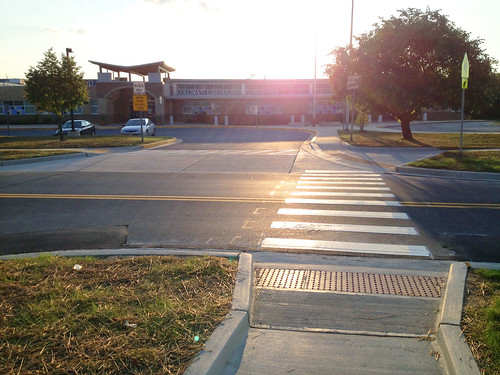 |
| A student at Bethesda Elementary School. Photo by Ronit Dancis. |
Tracy Simmons walks her two kids a mile to Bethesda Elementary every day. She says it's simply not safe, citing sidewalks too narrow to walk on, poorly-timed stop lights, and drivers who speed and don't yield to small children crossing the street. "Drivers need to stop thinking about their destination and be aware of what's going on around them," she says. "The streets are for everyone and everyone has the right to be safe while on them."
The Action Committee for Transit, a transit and pedestrian advocacy group, joined with the Washington Area Bicyclist Association and area parents to launch the Safe Walk To School campaign last spring, asking MCDOT to make small improvements that could make walking to school safer.
According to the National Center for Safe Routes to School, nearly half of all children between 5 and 14 walked to school in 1969. 40 years later, just 13% did. Studies show that kids who walk or bike to school are healthier, more independent and even learn better. But many parents won't let their kids walk to school due to fears about safety. Fast, wide streets that favor drivers can make walking to school quite dangerous.
 |
| Last year, a student died while walking to Seneca Valley High School in Germantown. Photo from Google Street View. |
Yesterday morning, members of ACT and local parents handed out flyers and balloons outside Bethesda Elementary to raise awareness about their campaign. Safe Walk to School's list of recommended safety improvements are small: they include a maximum speed limit of 20 and banning right turns on red in school zones, higher fines for speeding violations, more visible crosswalks, and changing traffic signals to give pedestrians more time to cross. But together, they could have a big impact on pedestrian safety.
ACT board member Ronit Dancis says one parent told her that he's physically pulled kids out of the intersection in front of the school to avoid cars making illegal right turns at a red light. "I've spoken with parents throughout Montgomery County who want their children to be able to walk (and bike) safely to school," says Dancis. "They are frustrated by how difficult it is."
 |
| A new crosswalk outside Galway Elementary School. Photo by the author. |
The school is located on a busy neighborhood street with other things kids might walk to, like a park, a church, and a swim club. But even those who live 4/5 of a mile away like my brother, a former student, rode the bus there instead.
Montgomery County is finally beginning to take pedestrian safety seriously. County police held a sting for drivers who didn't yield to walkers last spring, writing 72 tickets in 2 1/2 hours at one crosswalk on Veirs Mill Road in Wheaton. MCDOT is also doing community outreach, hosting events to raise awareness about safety issues.
 |
| New bumpouts will help slow traffic outside Galway Elementary School. Photo by the author. |
And the agency has been reluctant to accommodate walkers outside of school zones as well. Traffic engineer Bruce Johnston told residents at a meeting in White Flint in June that if they want "complete streets" designed for pedestrians and bicyclists in addition to drivers, they should tell the governor.
Downtown Bethesda resident Wendy Leibowitz notes that walking to school isn't as new or foreign an idea as some make it sound. "I challenge [transportation officials] to think back to their own trips to school when they were young. Can we provide a similar safe walk to our kids?" she says.
"Or do we have to spend hundreds of thousands of dollars to bus children small distances so the kids can be home by 3:30 in front of a screen of some kind?" adds Leibowitz. "Then we hear lectures about childhood obesity and screen addiction."

No comments:
Post a Comment